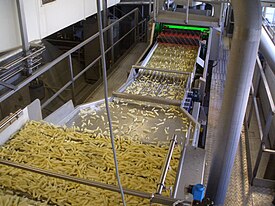The examples and perspective in this article may not represent a worldwide view of the subject. (July 2015) |


Food grading involves the inspection, assessment and sorting of various foods regarding quality, freshness, legal conformity and market value.[1][2] Food grading is often done by hand, in which foods are assessed and sorted.[1][2] Machinery is also used to grade foods, and may involve sorting products by size, shape and quality.[1][2] For example, machinery can be used to remove spoiled food from fresh product.[1][2]
- ^ a b c d Saravacos, George D.; Maroulis, Zacharias B. (2011).Food Process Engineering Operations. CRC Press. pp. 198-199. ISBN 1439877858
- ^ a b c d Sivasankar, B. (2002). Food Processing and Preservation. PHI Learning Pvt. Ltd. pp. 175-177. ISBN 8120320867
© MMXXIII Rich X Search. We shall prevail. All rights reserved. Rich X Search
